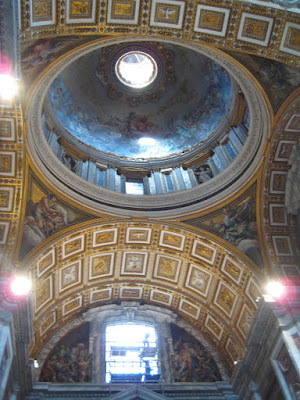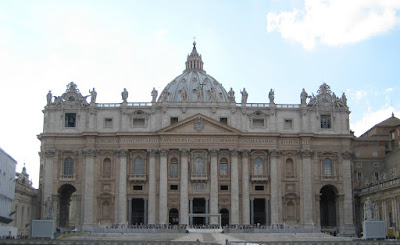Basilica Sancti Petri
(those little tiny things lined up across the front are people)
St. Peter's Basilica
We've certainly seen our share of cathedrals and basilicas. I suppose I now know why this one is the most famous. It's not only huge, it's definitely the most ornate and beautiful of any I've ever seen.

There is no way to capture the scale of this thing. Here's some perspective . . . those letters across the top are 8 feet tall. Eight feet! The sun is a bit bright, but perhaps you can see a guy working in that window.

Here's a better view . . .

This window alone must be 20 feet tall.

Another one of the most famous sculptures and one of the first things you see to the right of the entrance is Michelangelo's famous sculpture called the Pieta'. The word pieta' means "pity" in Italian. The statue, carved in 1498-1499, depicts the body of Jesus on the lap of his mother Mary.

It is the only piece he ever signed. According to an Italian historian, Michelangelo overheard someone remark that it was the work of another sculptor so Michelangelo signed the sculpture with MICHAELA[N]GELUS BONAROTUS FLORENTIN[US] FACIEBA[T] (Michelangelo Buonarroti, Florentine, made this) on the sash running across Mary's chest. It is said that he later regretted his outburst of pride and swore never to sign another of his works.

The really nice thing about almost every painting, sculpture, tapestry, is that none of them are behind glass. Usually a rope is in front, but that's all. Except for this one.
Apparently in 1972, a deranged geologist attacked the statue with a hammer. The damage was repaired, but now we all get to see it through glass. Of course if your some sort of Asian diplomat you get to go behind the glass. Naturally, they took pictures :)

Michelangelo was also the main architect for a while and designed the dome of the present church. The original basilica on this site was from the 4th century begun by Emperor Constantine.

Construction of St. Peter's began in 1506 and was completed in 1626. The building covers nearly 6 acres. It still fascinates me that people had the foresight to start a project that ultimately took 120 years to complete. No one who began the project saw it to completion. Even with modern technology and construction machinery, it is rare to see an undertaking like this today as pre-fab, synthetic, and faux have replaced it.

St. Peter's Basilica stands on the site where the apostle Peter was crucified and buried.
It is recorded in the Biblical book of the Acts of the Apostles that after the crucifixion of Jesus in the 1st century AD, Simon known as Peter took a leadership position among Jesus' followers. It is believed that after an approximate 30 year ministry, Peter travelled to Rome where he was executed during the reign of Roman Emperor Nero in 64 AD. Peter's remains were buried near his execution site and is now the site of the basilica.
Interesting factoid . . . In 1939, Pope Pius XII began 10 years of archaeological research under the crypt of the basilica, an area inaccessible since the 9th century. Indeed, it was discovered that the area now covered by the Vatican City had been a cemetery for many Christian burials including St. Peter.

This is his tomb in the crypt below the church. I guess this is one more thing with a glass front. They are actually doors, but visitors are not allowed to enter.

This is an ancient bronze statue of St. Peter (c. 1300), sculpted by Arnalfo di Cambio.

The feet are completely worn down from centuries of pilgrims touching it. It is thought that this was encouraged by Constantine, but with another statue.
This is Gian Lorenzo Bernini's Baldacchinno, the canopy covering the papal altar. You can see by the people milling around how large this canopy really is. It is 98 feet tall (that's like nearly 10 stories) and said to be the largest piece of bronze in the world.
This is Cathedra Petri (Throne of St. Peter). It is said to have actually been used by St. Peter, but it likely dates from the 12th century. When it began to deteriorate, Bernini was commissioned to enshrine it.

Interesting trivia . . . St. Peter's has a strict dress code: no shorts, no skirts above the knee, and no bare shoulders. You will not be let in if you don't come dressed appropriately. In a pinch, men and women alike can buy a big, cheap scarf from a nearby souvenir stand and wrap it around their legs as a long skirt or throw it over their shoulders as a shawl. If you're still showing too much skin, a guard hands out blue paper capes similar to what you wear in an (American) doctor's office.




Been trying to catch up. These pictures are so amazing!! Thanks so much for giving such a great tour!
ReplyDelete